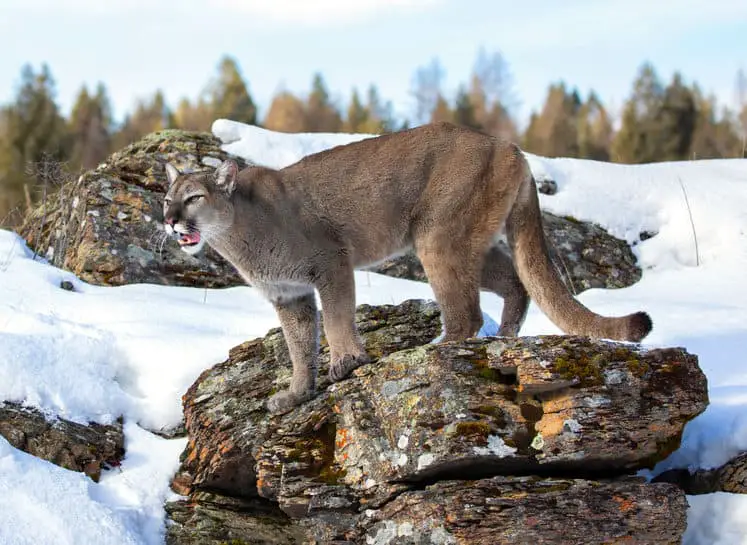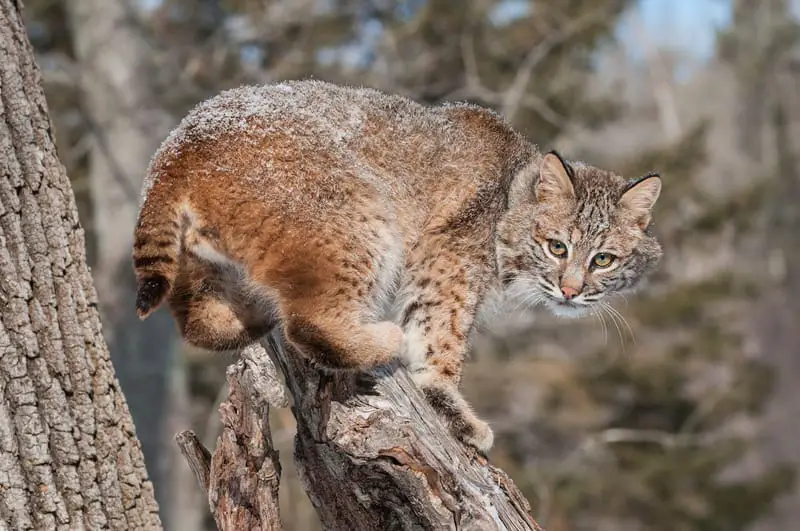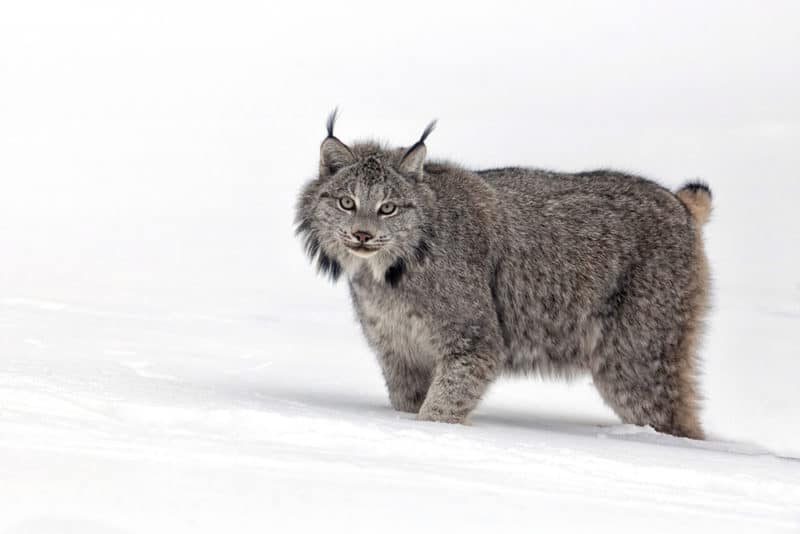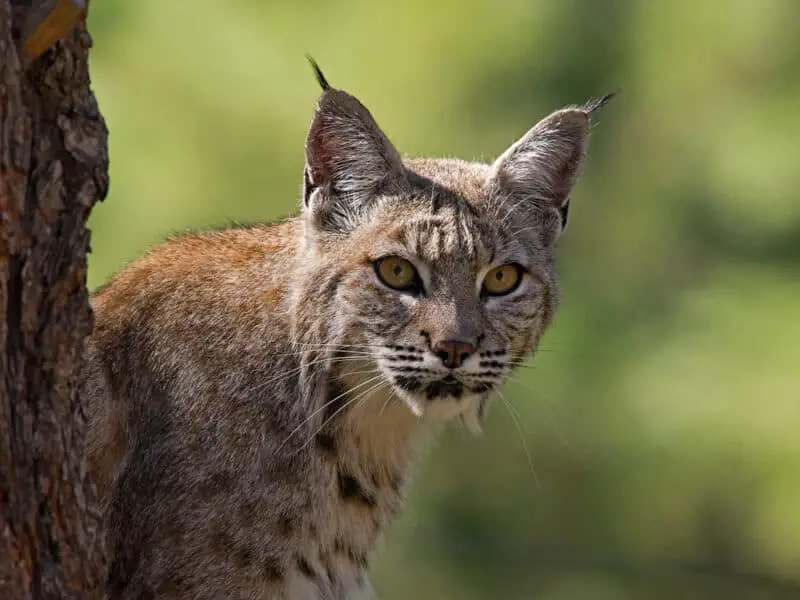The 3 wild cat species that are native to the state of North Dakota are the mountain lion, the bobcat, and the Canada Lynx. Mountain lions and Bobcats still live in North Dakota. On the other hand, Canada Lynx has been expatriated from the state.
Below we’ll talk about each of these 3 wild cat species.

Mountain Lions in North Dakota (Puma concolor)
Due to the fact that they live in a wide geographical area, mountain lions have a long list of regional names. In recent years, their scientific name was even changed from (Felis concolor) to Puma concolor. Some common names that mountain lions go by are cougar, panther painter, Andean Mountain lion, and puma.
Where Do Mountain Lions Live?
Mountain lions live on all three of the American continents. Their range begins in Canada’s Yukon territory and extends south through parts of North America, Central America, and South America to the southern tip of Argentina.
In Canada, the biggest cougar populations are in British Columbia and Alberta. On the other hand, in the United States, they mainly live in the western United States and Florida in the southeast. In Florida, the cougar is called the Florida panther.
According to the North Dakota Game and Fish website, there is a breeding population of Mountain lions in the state’s badlands region, as well as the Missouri River breaks.
There are also small numbers of cougars in the Turtle Mountains, which are in the north-central portion of North Dakota.
Finally, because these animals are capable of traveling large distances, there are occasional mountain lion sightings in all parts of the state.

What do Mountain Lions Look Like?
To visualize what a mountain lion looks like, picture a giant house cat with short, light brown fur. Mountain lions are much larger than domestic cats, though. Average house cats weigh in at around 10 pounds, while male mountain lions occasionally weigh over 200 pounds.
These large cats have muscular slender bodies, rounded small heads, and upright ears that are oval at the tip. Another characteristic that mountain lions have is their muscular long tails, which account for almost one-third of the entire length of the animal. They use their long tail for a counterbalance, moving it from side to side as they navigate through uneven terrain.
Mountain lions have a tan coat of short, coarse hair over most of their body. The area around their nose, the tip of their tail, and the tips of their ears are black. Their belly, the area above their upper lip, below their lower lip, and their chin are all white. They also have a sprinkling of dark hair on their backs. There are some coat color variances between different geographic locations.
Mountain lions are the second largest cat in the western hemisphere, smaller only than the Jaguar (Panthera onca). However, worldwide, the African Lion (Panthera leo) and the Tiger (Panthera tigris) are also larger.
Male and female mountain lions are phenotypically identical in every respect except for size. Males are 30 to 40% bigger than females. Though sizes vary considerably throughout the cat’s geographic range, an adult male typically weighs between 110 and 180 pounds, 50 to (82 kgs). A rare few of them grow bigger than 200 pounds (91kgs). Female mountain lions or queens average between 80 and 130 pounds (36 to 59 kgs). Adult males or toms will reach a length of 6 to 8 feet (1.8 to 2.4 M) from their snout to the tip of their tail. On the other hand, adult females are 5 to 7 feet long (1.5 to 2.1 M).
Large Cats But Not Big Cats
A fun fact is that despite their large size, they are not taxonomically classified as big cats because they cannot roar. Snow leopards, for example, are smaller than mountain lions, but since they can roar and cannot purr, they are classified as big cats, while mountain lions are not. Another interesting thing that I can mention here is that mountain lions purr.
Since they purr and cannot roar, mountain lions are in the Felis genus, while big cats that cannot purr and can roar are in the Panthera genus.
As of the year 2017, mountain lions are taxonomically divided into 2 sub-species. The first is (Puma concolor couguar) or northern cougar. Northern cougars range through North America, Central America, and possibly northwestern South America. The second sub-species is (Puma concolor concolor) or southern cougar. These cats range only in South America.
What do Mountain Lions Eat?
Mountain lions account for around 18 pounds of biomass and consume around 10 pounds of meat per day. To do this, an adult mountain lion has to kill a deer or a deer’s equivalent in meat around once a week. A mountain lion’s preferred prey is deer. However, they also prey on other animals.
In North Dakota, mountain lions prey on mule deer, white-tailed deer, elk, bighorn sheep, pronghorns, feral horses, coyotes, raccoons, rabbits, wild turkeys, miscellaneous birds, pack rats, various small rodents, prairie dogs, porcupines, skunks, snakes, pets, feral cats, livestock, and any other native wild animals they can catch.
Mountain Lion Behavior
Mountain lions are solitary animals. It’s a rarity to see 2 or more together unless during mating or in the case of a female raising young. They have expansive home ranges.
An adult male’s home range is normally more than 100 square miles and up to 250 square miles. They will sometimes mark their territory by leaving claw marks on trees. They also scratch up piles of leaves and or pine needles that they urinate on as a scent marker. Male mountain lions fight to the death sometimes to defend their territory.
Do Mountain Lions Ever Harm Humans?
I’ve taken much of the following section from another one of my blog posts entitled “Are Mountain Lions Dangerous?” Found here.
Fatal mountain lion attacks on humans are extremely rare. In fact, there are only 20 records of fatal mountain lion attacks on humans in all of North America in the last 100 years. Don’t let that fact lull you into a complete sense of false security, though. There have been many more mountain lion attacks over the years that didn’t result in a fatality. Mountain lions are, in fact, dangerous.
Mountain lions are formidably tough large predators. They can run 40 to 50 miles per hour for short bursts. Additionally, they can leap 18 feet vertically and 40 feet horizontally to catch their prey. These ninja-like predators typically stalk their prey from behind and then leap on an animal’s back. They then crush their cervical spine or larynx with their powerful jaws. They have a bite force of 750 pounds per square inch.
Here are a couple of recent examples of non-fatal mountain lion attacks on humans. See See
Some factors that cause mountain lions to attack humans
The majority of the time, mountain lions use their ghost-like skills to avoid human contact. On rare occasions, though, they attack humans. Below are a few of the reasons why.
- If the cougar has an injury or some sort of impairment that prevents it from killing its normal prey, it’ll be more likely to look at a person as potential prey.
- Male mountain lions engage in fights for territory. Some of their battles are to the death. A percentage of cougar attacks on humans are perpetrated by hungry young males who have been kicked out of territories with a more abundant food supply.
- Scientific data suggests that mountain lions that were orphaned at a young age are more likely to attack humans. This is possibly because they missed the part of their training where their mothers taught them that humans are to be feared.
If a mountain lion is stalking you
- Never run away. According to a Multidisciplinary Journal of the Interactions of People and Animals, those who try to run away when they encounter a mountain lion put themselves at greater risk of sustaining serious injuries and even death. Running away triggers a lion’s instinct to chase.
- Stay as calm as you can. Panic is your enemy. In a survival situation such as this, a cool head will put you at a better advantage.
- Speak firmly in a loud voice but avoid a high-pitched tone or screaming
- You need to hold your ground when the cat is coming towards you and slowly back away when it pauses its approach
- Stand upright. Avoid bending over or crouching down as much as possible, as this puts you in the vulnerable position of appearing like a small, four-legged animal that can easily become prey.
- Open your jacket if you’re wearing one to appear larger. and wave your arms slowly to give yourself the appearance of having as much size as possible as you back away slowly. You can also throw stones, tree branches, or other objects at the lion.
- If you’re walking with a child, pick them up and hold them in your arms.
If you’ve done all the above, there’s still that small chance that you’ll still be attacked by the mountain lion. You need to be mentally prepared for this. At this point, do not panic and freeze up. In order to survive, you’ll need to fight back with as much aggression as you can muster.
Historical accounts show that people have successfully fought mountain lions off with their bare hands, sticks, rocks, garden tools, or any other weapon within reach. You already have a ready-made weapon if you’re using a walking stick. Target sensitive areas such as the eyes and nose, and hit as hard as you can! You should also try to remain standing if possible. You’ll lose some of your advantage on the ground. If you get knocked down, try as hard as possible to protect your neck and head as you continue to fight back.

Bobcats in North Dakota (Lynx rufus)
The Bobcat, which is also known as the red lynx, is a North American wild cat. Biologists believe that both the bobcat and the Canada lynx are descendants of the Eurasian lynx whose ancestors crossed into North America via the Bearing Sea land bridge.
Bobcats reside only in North America. Their range begins in Canada. Central British Columbia is the furthest north that bobcats live. Their range extends south through the United States and down into central Mexico. They are the most common wildcats in North America.
According to the North Dakota Game and Fish Department, there is a stable bobcat population in the southwestern portion of the state, where they also hold a limited bobcat trapping and hunting season.
Per this 2022 interview with Steph Tucker, who is a section leader and furbearer biologist with the North Dakota Game and Fish Department, there is also an expanding bobcat population in northeastern North Dakota. Look for them in rough, rugged habitats along riparian areas, rocky buttes, and timbered draws. Bobcats do not hibernate. They are active throughout the year. However, they’re rarely seen since they’re predominantly nocturnal or crepuscular animals. See
What do bobcats look like?
A bobcat is much smaller than a mountain lion and slightly smaller than a Canadian lynx. An average bobcat is about twice the size of a domestic cat.
A bobcat is 2 to 3 feet long and weighs about 15 to 35 pounds. A female bobcat is quite a bit smaller than a male.
These animals have a “bobbed,” short tail with black bands on its upper surface. Their tail also has a black tip on its upper surface but not the back. Their fur is usually gray to brown, with mottled black spots that range from black to dark brown on their bodies. They also have black stripes on their inner forelegs and tail.
From a side view, you will notice that a bobcat is slightly higher at the rump than at the shoulders. Bobcats and lynx have long hind legs in proportion to their forelegs.
Bobcats have black-tufted ears. In other words, they have tufts of hair that poke up above their ears and are black at the tips. They do have shorter ear tufts than their close relative, the Canadian lynx.
The backs of their ears, below the black tips, are black. In the center of the black of each ear, they have a single white spot. This gives the impression of a false eye on the back of each ear.
They also have a whiskered face that seems broader due to their long ruffled facial hair and whiskers. Their eyes are yellow with round black pupils.
Compared to Canadian lynx, which thrive in deep snow country, bobcats struggle more in the snow due to the fact that they cannot walk on top of it like lynx can. A lynx’s large paws function like snowshoes keeping it on the snow’s surface. On the other hand, compared to lynx, bobcats have small feet that tend to sink into the snow. If the snow is too deep and powdery, it reduces their mobility along with their ability to catch prey.
This is why the bobcat range dies out in southern Canada; from there on to the north, Canadian lynx are more prevalent and bobcats less so.
Bobcats are also unable to live at higher elevations as lynx do in the winter. In the winter, lynx are able to stay in the high country to hunt their preferred prey, snowshoe hares.
What do bobcats eat?
Despite their comparatively small size, bobcats are aggressive, tough predators. At times, particularly during the winter, they prey on large mammals that are much larger than they are, such as deer. However, their regular diets mainly consist of small mammals, reptiles, amphibians, birds, insects, and carrion.
When they take up residence close to a residential area, their menu might occasionally also include small agricultural animals and small pets.
Interestingly, they even prey on venomous snakes even though they are not immune to the venom. They accomplish this by using their quickness to pin the snake’s head down with a paw, after which they dispatch the snake with a quick bite to its spine behind the head.
The Prairie Rattlesnake (Crotalus viridis) is North Dakota’s only venomous snake species. See

Canada Lynx in North Dakota (Lynx canadensis)
Canada Lynx are native to North Dakota. However, they are extirpated from the state. This section on Canada Lynx has been largely taken from the Krebs Creek post, Wild Cats in Maine.
The Canada lynx is a medium-sized forest-dwelling cat. They live in the boreal spruce-fir forests in the mountainous areas of Canada and the northern United States. They are 1 of 2 North American members of the “Lynx” genus. The other one is the bobcat.
Canada lynx ranges over most of Alaska with the exception of the Yukon –Kuskokwim River delta on the Bearing Sea and the southern end of the Alaska Peninsula. Source
They also range over most of Canada, with the possible exceptions of southeastern Alberta, southern Saskatchewan, southwestern Manitoba, and coastal British Columbia. Although they venture beyond the treeline, they are absent from areas that are very far above it.
In the contiguous United States, there are resident breeding populations of lynx in Montana, Washington, Maine, New Hampshire, Minnesota, and Colorado.
In the contiguous United States and Canada, lynx are protected under the federal endangered species list.
Canada Lynx Characteristics
What does a Canada lynx look like? The Canada Lynx shares a lot of physical similarities with its close relative, the bobcat. But the two also share some differences. First of all, lynx are slightly larger than bobcats. Adult lynx are up to 35 1/2 inches (90 cm) long and 26 inches (65 cm) tall. Additionally, they weigh up to 37 and a half pounds (17 kg). While the tail of a bobcat is short or “bobbed,” a lynx’s tail is shorter still.
Lynx don’t have the black bands on the topside of their tails that bobcats have. However, they do have a completely black-tipped tail. The black tip on a lynx’s tail surrounds the entirety of the tail as if the tail had been dipped in black paint. On the other hand, a bobcat’s black tip is only on the top side of the tail.
Canada Lynx have long, thick grey fur in the winter. By summertime, they have shed their grey fur and have a thinner, shorter reddish brown hair coat instead. Their color is more uniform than that of bobcats. While bobcats have black spots and mottled coloration over their entire body, Lynx are solid tan except for some mottled darker brown spots on their legs.
Canada Lynx have triangular pointed ears with black backs and long tufts of black hair on the tips. The hair tufts are much longer than a bobcat’s. They also have drooping flared facial ruff of white hair on the sides of their face beneath their chin.
Their eyes are green with round black pupils.
Lynx have long legs in proportion to their bodies, with their hind legs being slightly longer than their front ones. This gives their body a peculiar, downhill-sloped appearance.
Canada Lynx have almost comical-looking oversized fur-covered paws. They put their larger feet to good use. Their large paws function like snowshoes, allowing them to travel and hunt on top of the snow. Canada lynx feet can keep almost twice as much weight from sinking into the snow as those of a bobcat. This is why they range over the deep snow country of northern Canada while bobcats do not.
What Do Canada Lynx Eat?
Mice, squirrels, ptarmigan, grouse, ducks, deer, Dall sheep, and caribou make up a minor portion of a Canadian lynx’s diet in regions where these prey animals are available. However, over most of their range, their preferred food is Snowshoe hares.
Lynx and Snowshoe Hares
The Canada lynx is very dependent on snowshoe hares as a food source. In some areas, hares comprise 75 percent of their total diet. In fact, their population density is directly correlated with the snowshoe hare population.
Canadian and Alaskan Canada Lynx and snowshoe hares go through what is known as the Lynx-Snowshoe Hare Cycle. When food sources are abundant for hares, their population increases very rapidly since they can have several litters per year. When hare populations are at their peak, there can be as many as 1500 animals per square kilometer, ”3913 per square mile”. At this time, the population of Lynx and other predators are also at their peaks.
Reproductive Behavior and Life Cycle for Canadian Lynx
Breeding season for the Canada Lynx begins in late February and goes to early April. Lynx females are mono estrus, meaning they have one estrus cycle per year. Females mate with only one male and are in heat from 1 to 10 days. On the other hand, males may mate with multiple females.
Reproduction in Canadian lynx is directly affected by the abundance or lack of their prey animals. If they successfully mate, their gestation period lasts 56 to 70 days.
The pregnant female will typically make a maternal den beneath rock ledges, a fallen log, in the root tangle of a fallen log, or a thick tangle of brush.
Lynx kittens are sightless for the first two weeks of their life. By the time they’re 5 weeks old, they’ll be big enough to leave the den. Their mothers wean them when they’re around 10 weeks old, and at 10 months, they’ll go out on their own. Source
Female Lynx are sexually mature at 10 months old, but they generally don’t come into heat for at least another year. However, in periods of prey abundance, yearling females will breed and give birth.
Male Lynx reaches maturity at around 33 months of age.
The lifespan of a Canadian lynx is somewhere between 10 and 20 years in the wild. They can live over 20 years in captivity. See
Recent Posts
The only venomous snakes in Washington State are Northern Pacific Rattlesnakes. The Northern Pacific Rattlesnake (Crotalus oreganus oreganus) is a sub-species of the Western Rattlesnake. Anyone...
Skunks are not classified as true hibernators. But they go into a state of torpor when the weather gets cold. Skunks are light sleep hibernators, along with opossums, bears, and raccoons. ...

